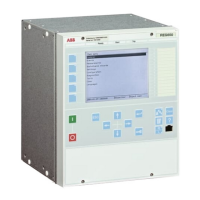they are also called internal signals. The internal signals can be divided into two
groups.
• Standard signals are always presented in the IED, see Table 488.
• Hardware dependent internal signals are collected depending on the hardware
configuration, see
Table 489.
Explanations of internal signals are listed in Table 490.
Table 488: SELFSUPEVLST standard internal signals
Name of signal Description
Internal Fail Internal fail status
Internal Warning Internal warning status
Real Time Clock Error Real time clock status
Time Synch Error Time synchronization status
Runtime App Error Runtime application error status
Runtime Exec Error Runtime execution error status
IEC61850 Error IEC 61850 error status
SW Watchdog Error SW watchdog error status
Setting(s) Changed Setting(s) changed
Setting Group(s) Changed Setting group(s) changed
Change Lock Change lock status
File System Error Fault tolerant file system status
DNP3 Error DNP3 error status
Table 489: Self-supervision's hardware dependent internal signals
Card
Name of signal Description
PSM PSM-Error Power supply module error status
TRM TRM-Error Transformator module error status
COM COM-Error Communication module error status
BIO BIO-Error Binary input/output module error status
AIM AIM-Error Analog input module error status
Table 490: Explanations of internal signals
Name of signal
Reasons for activation
Internal Fail This signal will be active if one or more of the following
internal signals are active; Real Time Clock Error, Runtime
App Error, Runtime Exec Error, SW Watchdog Error, File
System Error
Internal Warning
This signal will be active if one or more of the following
internal signals are active; IEC 61850 Error, DNP3 Error
Real Time Clock Error This signal will be active if there is a hardware error with the
real time clock.
Table continues on next page
1MRK 502 048-UEN A Section 17
Basic IED functions
619
Technical manual

